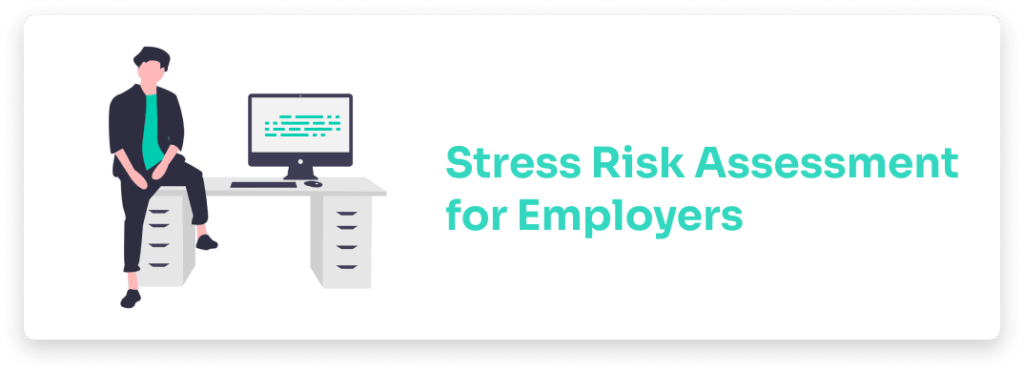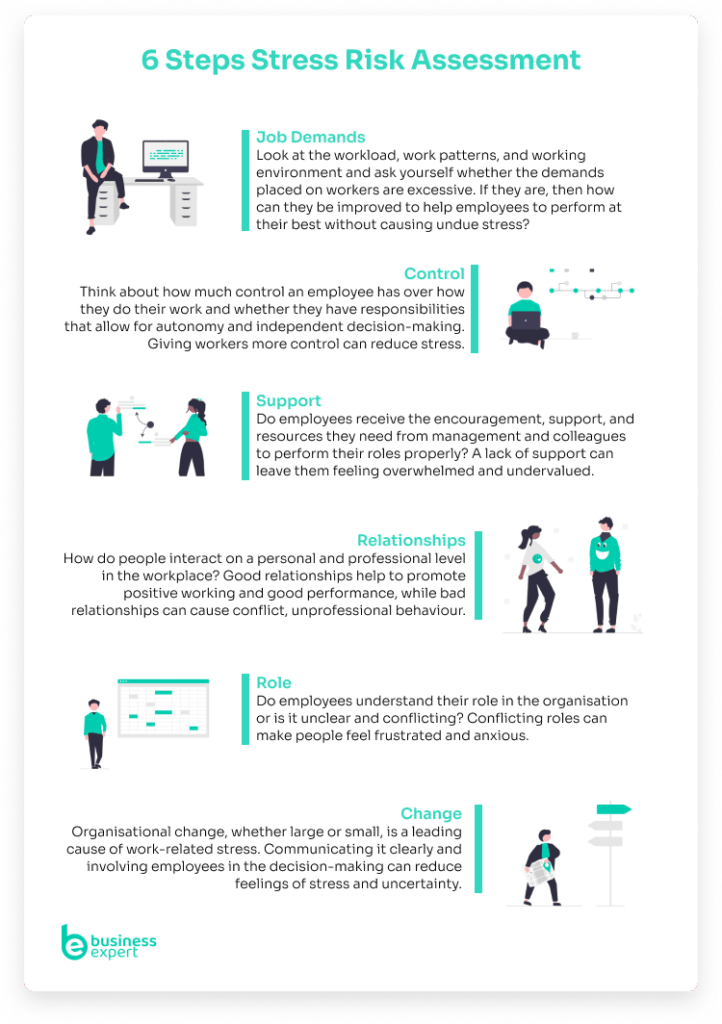What is a stress risk assessment for employers, how do you complete one, and how it can help? Also, find stress risk assessment templates from the HSE.
Employers have a legal duty to look after the health and wellbeing of their employees, and that includes their levels of stress. Given this duty of care, it’s perhaps surprising that according to Deloitte, only 76% of line managers believe the wellbeing of their team is their responsibility. That means almost one-quarter of all line managers take no responsibility for the wellbeing – including minimising stress – of their employees.
Whether you’re an employer or a line manager, identifying the causes and managing stress in the workplace can have profound business benefits. That includes boosting productivity and performance, reducing absenteeism, and minimising conflict. The first step in realising those benefits is to conduct a work-related stress risk assessment.
Here, in part 3 of our guide to Managing Business Stress, we will look at what a work-related stress risk assessment is, the steps you should take to complete one, and how it can help. We’ll also provide links to some stress risk assessment templates that you can follow.

What is a Stress Risk Assessment?
A stress risk assessment for employers is a careful examination of the different factors in a workplace that could cause staff to suffer from work-related stress and the steps you can take to minimise them.
Stress risk assessments don’t have to be long and complicated documents, and, if you have fewer than five employees, then you don’t have to write anything down at all. However, by law, you do need to conduct one and act on your findings. If you have five or more employees then you must write down the main points about the risks you found and what you have decided to do about them.
It’s important to note that you are not expected to eliminate all of the stressors completely. That is unrealistic and probably impossible, but you are expected to take reasonable steps to minimise the risks and protect your employees.
How to Conduct a Stress Risk Assessment
When conducting a work-related stress risk assessment, there are six factors, known as Management Standards, that the HSE says you should pay close attention to. They will guide you through the hazard identification stage of the process and help you identify issues that you otherwise may not have spotted.
- The Demands of the job
Look at the workload, work patterns, and working environment and ask yourself whether the demands placed on workers are excessive. If they are, then how can they be improved to help employees to perform at their best without causing undue stress?
- How much Control someone has over their work
Think about how much control an employee has over how they do their work and whether they have responsibilities that allow for autonomy and independent decision-making. Giving workers more control can reduce stress.
- Support received from managers and colleagues
Do employees receive the encouragement, support, and resources they need from management and colleagues to perform their roles properly? A lack of support can leave them feeling overwhelmed and undervalued.
- Relationships within the workplace
How do people interact on a personal and professional level in the workplace? Good relationships help to promote positive working and good performance, while bad relationships can cause conflict, unprofessional behaviour, and stress.
- The individual’s Role within the organisation
Do employees understand their role in the organisation or is it unclear and conflicting? Conflicting roles can make people feel frustrated and anxious.
- The management of Change
Organisational change, whether large or small, is a leading cause of work-related stress. Communicating it clearly and involving employees in the decision-making can reduce feelings of stress and uncertainty.
When looking at these six different factors, you should write down:
- The hazards identified
- The people at risk
- The control measures you have in place now
- The additional control measures you can put in place to minimise the risk
- The person(s) responsible for putting the controls in place
- The date the controls will be implemented by
What are the Benefits of Conducting a Stress Risk Assessment for Employers
As well as staying on the right side of the Management of Health and Safety at Work (MHSW) Regulations 1999), there are also plenty of business benefits associated with carrying out a well-planned stress risk assessment.
It is an important step in preventing issues such as burnout, presenteeism, and even long-term mental illness. It can also help to reduce rates of absenteeism and staff turnover. All of these are costs to your business that you could do without. A major work-related stress study (pdf) found that workload is by far and away from the leading cause of stress in the UK. More than half of women (53%) and 43% of men said their work-related stress was the result of their workload. Overworking can lead to poor quality work, more mistakes, and missed deadlines, all of which can increase your business’s costs and affect your reputation. That’s another reason why it’s so important to conduct a work-related stress risk assessment.

Work-Related Stress Risk Assessment Templates
Here is a workplace risk assessment template (Word Doc format) and some examples of completed stress risk assessments below, courtesy of the HSE.
